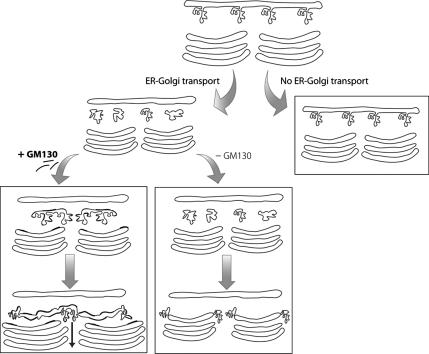Figure 9.
Model of the roles of membrane input from the ER and of GM130 in the biogenesis of the Golgi ribbon. In the absence of membrane input from the ER (no ER-to-Golgi transport) the Golgi ribbon undergoes disconnection into isolated stacks, the cis-fenestrated cisterna disappears and the overall length of the cisternae decreases. In the presence of membrane input from the ER (ER-to-Golgi transport) the ER-to-Golgi carriers (EGCs) are transported to the GC: if they acquire GM130 (+GM130), they undergo homotypic coalescence-fusion generating larger and more homogenous disk-like membranes that are directly incorporated into the stacks, contributing to a new fenestrated cisterna at the cis pole and participating in the formation of the ribbon. In the absence of GM130 (−GM130), the incorporation of the EGCs into the stacks is impaired and they remain as distinct entities that are however still able to deliver cargo through limited continuities with the GC. This causes the accumulation of tubulovesicular membranes, the disappearance of the highly fenestrated cis-most cisterna, the overall shortening of the cisternae and the disconnection of the Golgi ribbon.

